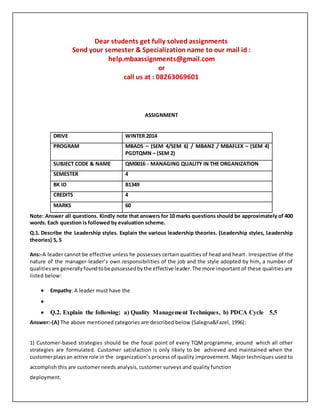
Qm0016 managing quality in the organization
- 1. Dear students get fully solved assignments Send your semester & Specialization name to our mail id : help.mbaassignments@gmail.com or call us at : 08263069601 ASSIGNMENT DRIVE WINTER 2014 PROGRAM MBADS – (SEM 4/SEM 6) / MBAN2 / MBAFLEX – (SEM 4) PGDTQMN – (SEM 2) SUBJECT CODE & NAME QM0016 - MANAGING QUALITY IN THE ORGANIZATION SEMESTER 4 BK ID B1349 CREDITS 4 MARKS 60 Note: Answer all questions. Kindly note that answers for 10 marks questions should be approximately of 400 words. Each question is followed by evaluation scheme. Q.1. Describe the Leadership styles. Explain the various leadership theories. (Leadership styles, Leadership theories) 5, 5 Ans:-A leader cannot be effective unless he possesses certain qualities of head and heart. Irrespective of the nature of the manager-leader’s own responsibilities of the job and the style adopted by him, a number of qualitiesare generallyfoundtobe possessedbythe effective leader.The more important of these qualities are listed below: Empathy: A leader must have the Q.2. Explain the following: a) Quality Management Techniques, b) PDCA Cycle 5,5 Answer:-(A) The above mentioned categories are described below (Salegna&Fazel, 1996): 1) Customer-based strategies should be the focal point of every TQM programme, around which all other strategies are formulated. Customer satisfaction is only likely to be achieved and maintained when the customerplaysan active role in the organization’s process of quality improvement. Major techniques used to accomplish this are customer needs analysis, customer surveys and quality function deployment.
- 2. Q.3. “Quality management principles have to be followed by the organization so as to achieve their organizational goals”. In the light of thisstatement,explainthe principlesofQuality Management.(Listing the principles, Explanation) 5, 5 Answers:- "A qualitymanagementprinciple is a comprehensive and fundamental rule / belief, for leading and operating an organisation, aimed at continually improving performance over the long term by focusing on customers while addressing the needs of all other stake holders".The eight principles are ... 1. Customer-FocusedOrganisation 2. Leadership 3. Involvementof People 4. ProcessApproach 5. SystemApproachto Management 6. Continual Improvement Q.4. a) ExplainExplain the concept of processre-engineering.b) BrieflyexplainCAPAsystem5, 5 Answer:-(A)Re-engineering: The basis for many recent developments in management is Re-engineering. Consider the cross functional team (a group of people with diverse functional expertise working towards a common goal) as an example has turn out to be popular due to the desire to re-engineer separate functional tasks into complete cross functional processes. Also, a lot of recent management information systems developmentsaspire tocombine awide numberof business functions. Business process re-engineering is also identified as business process redesign, business transformation or business process change management. Businessprocessre-engineering(BPR) isthe analysisandredesignof workflow insideand between enterprises. BPR reached maximum publicity in the early 1990s when authors Michael Hammer and James Champy publishedtheirbest-sellingbook, Businessprocessreengineering(BPR) isthe analysisandredesign of workflow within and between enterprises. Q.5. Discuss the importance of employee involvement for maximizing the quality. Explain the importance of team building for organizations. (Employee involvement and Quality, Importance of Team building) 5, answer:- Employee involvement:Empoweringyouremployees and involving them in decision making process provide an opportunityforcontinuousprocessimprovement.The available ideas,innovations, and creative thoughts of employeescanmake the difference betweensuccessandfailure.Employeeinvolvementandqualityisdepicted. Employee involvement plays a very important role in maximising the quality & productivity, because: o Employees make things to happen in a o o Q.6. Explain the theories of Motivation and Empowerment. (Theories of Motivation, Theories of Empowerment) 5, 5 Answer:-Theories of Motivation and Empowerment: We begin with the theories of motivation. According to Chandler (2004, 41-43) the most widely-known theory of motivation was the one developed by Abraham Maslow in his book entitled Theory of Human Motivation typically referred to as the hierarchy of needs.Maslowconstructedahierarchyof five levelsof basicneeds.Beyondtheseneeds,higherlevels of needs exist.These include needsfor understanding, appreciation and purely spiritual needs. In the levels of the five basicneeds accordingto Maslow,a persondoesnotfeel the secondneed until the demandsof the first 12 have been satisfied or the third until the second has been
- 3. Dear students get fully solved assignments Send your semester & Specialization name to our mail id : help.mbaassignments@gmail.com or call us at : 08263069601
